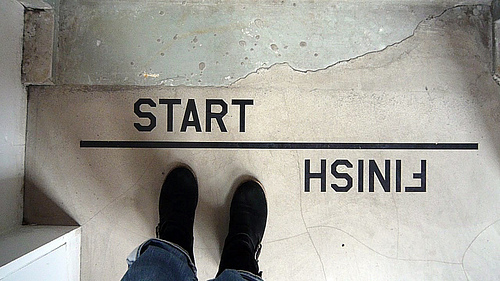Doing the Planning First
Read the “Starfish Parable” in the box below. Imagine that you are going to write an expository essay in response to this passage.

Source: Starfish, Logan Sakai, Flickr
The Starfish Parable
An old man had a habit of early morning walks along the beach. One day as he looked down the shore, he saw a human figure moving like a dancer. As he got closer, he saw that it was a young woman and that she wasn’t dancing but instead was reaching down to the sand, picking up starfish, and very gently throwing them into the sea.
“Young lady, why are you throwing starfish into the sea?”
“The sun is up and the tide is going out, and if I don’t throw them in they’ll die.”
“But there are millions of them; what difference can it make?”
The young woman listened politely, paused and then bent down, picked up another starfish, and threw it into the sea past the breaking waves. She said . . .
“It made a big difference to that one!”
Is it worth making a small difference when it will not help toward making any big difference? Think carefully about this question. How would you go about writing an essay in response to this question?
First, you would probably do some freewriting about “making small differences that make no big differences.” As you did the freewriting, you would get a better idea of what thesis position to take. You might not keep this thesis exactly as it came out during the freewriting, but you would know enough about your main point to do a webbing chart, also called a mind map.
Let’s assume you have done the freewriting and you’re ready to organize your thesis and supporting ideas. Since you are just practicing, some ideas have been prepared for you in this lesson. All you have to do is select a thesis, some supporting ideas, and some examples from the “idea bank” and arrange them in a webbing chart.

Source: START finish, domit, Flickr
“Wait a minute! I thought this lesson was about introductions and conclusions. Why am I being asked to organize ideas for the body paragraphs?” Good question. We are going to get to introductions and conclusions very soon. But we have to have the ideas for our essay in mind before we can write an introduction or make a concluding statement about them.
- For the next exercise, read the list of ideas at the bottom of the box and then choose the one you think could be the thesis of an essay about “helping in a small way when it will not make any difference in a big way.” Remember that the thesis is your main idea; the other ideas in your essay should support this idea. Look for the “biggest” idea in the choices below.
- Select the one you think could be a thesis and drag it into the oval. If you select correctly, four ovals for the supporting ideas will appear.
- Drag the supporting ideas into the new ovals. If you choose, correctly, the last set of ovals will appear.
- Drag the text that illustrates each supporting idea into the remaining oval.


Source: iStockphoto
You need to do some planning like this before you begin writing an essay. Why not just plow ahead with the first sentence of the introduction and keep writing until you get to the conclusion, you might ask?
The introduction gives a preview of the main points in your essay (at least a statement of your thesis), and the conclusion provides a “final reminder,” a summary of your main points. You can’t introduce a new person to your friends without knowing something about that new person. Likewise, without doing some planning (freewriting, webbing, talking with other people, listing, diagramming, anything that helps you envision the ideas in your essay in relation to each other), you will not know what you are introducing. The supporting details you just organized in the chart are summaries for the main points that will appear in your essay.
Since you know the main ideas and have organized them in a webbing chart, you are ready to explore how to write an effective introduction for your essay. Later in this lesson, you will learn how to finish the essay with an effective conclusion. You also need to keep in mind that the next sections of the lesson assume you believe the thesis you selected. However, even if you don’t believe it, pretend that you do for the purpose of this lesson.
Tip for advanced writers: Many writers learn that it’s actually a good idea to wait until after the body paragraphs of the paper are written before writing the introduction. This is especially true for in-class exams and timed writings. The introduction is often the part of your essay that requires the most creativity; it’s the part that readers expect to be interesting and, if possible, dramatic. Sometimes it’s best to leave the introduction until the rest of the essay has been written. This strategy allows you to relax and let the creative juices flow.